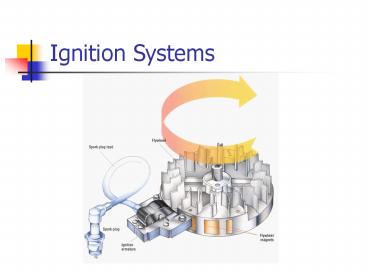Ignition Systems PowerPoint PPT Presentation
1 / 31
Title: Ignition Systems
1
Ignition Systems
2
Class Plan Wed. Nov 3.
- Chat about Ignition Systems
- Demo Ignition Tools
- Spark Plug Testing Activity
3
Outline
- Magnets and electricity
- Ignition components
- Basic ignition system operation
- Types of ignition systems
- Solid state ignition system
4
Magnets and Electricity
- Conductor A material or an object that allows
electricity to flow easily Ex Gold, copper,
aluminum - Insulator A material or an object that dont
allow electricity to flow easily Ex Glass,
Porcelain, wood
5
Magnets and Electricity
- Magnetic Field
- The space around a magnet that contains a force
of attraction - This force of attraction is called magnetic lines
of force or magnetic flux
6
Magnets and Electricity
- If a conductor, such as copper, is moved so that
it cuts magnetic lines of force, an electron flow
is induced in the conductor
7
Magnets and Electricity
- A conductor that is not moving and not cutting
magnetic lines of force will not induce
electrical current
8
Magnets and Electricity
- Magnetic Induction - If a conductor is moved
through a magnetic field, a voltage will be
induced on that conductor.
9
Ignition Components
- Switch electrical device that turns the current
on and off - Capacitor (condenser) electrical component that
can store an electric charge.
10
Ignition Components
- Diode Rectifier Changes alternating current to
direct current - Silicon-controlled Rectifier (SCR) consists of
a diode and transistor and is used as a switching
device in electronic circuits
11
Ignition Components
- Magnets Attached to the flywheel and are used
to induce an electric current around the armature
12
Ignition Components
- Armature/coil consists of a coil wrapped around
an iron core. The coil is a small transformer
that steps-up low voltage (6-12v) to high voltage
(20 40kv)
13
Ignition Components
Low Voltage Lead
High Voltage Lead
14
Ignition Components
- Primary Winding
- Thick wire that is wrapped around the core
between 150 and 200 times. - The primary winding is the low voltage wire that
carries 6-12 volts
15
Ignition Components
- Secondary Windings
- Thin wire that is wrapped around the primary
winding about 20,000 times - The secondary winding is the high voltage wire
that carries 20,000 40,000 volts
16
Ignition Components
- Low Voltage Lead carries low voltage from the
battery or armature to primary side of coil - High Voltage Lead carries high voltage from the
secondary side of the coil to the spark plug
17
Ignition Components
- Spark Plug
- provides a gap for electricity to jump across,
producing a spark that will ignite the engines
fuel
18
Basic Ignition System Operation
- As the flywheel spins, the magnets move close to
the armature/coil. - The magnetic field induces an electrical current
in the primary windings - The current induces a voltage in the secondary
winding
19
Basic Ignition System Operation
- When the current flow through the primary winding
is stopped the magnetic field collapses rapidly
and will induce a high voltage current in the
secondary winding. - The current then runs directly to the spark plug
and causes a spark to jump across the spark plug
gap.
20
Ignition Tools
- Micrometer
- Caliper
- Feeler Gauge
- Spark plug tester (Ignition tester)
- Spark plug wrench
- Flywheel holder
- Torque Wrench
- Dial Bore Gauge
21
Three Types of Ignition Systems
- 1. Magneto Ignition System
- 2. Battery Ignition System
- 3. Solid State Ignition System
22
Magneto Ignition System
- Generates power through magnetic induction.
- Contains mechanical components (breaker points)
that perform the switching action in the ignition
circuit
23
Battery Ignition System
- A battery is used to provide power to the
ignition circuit instead of magnetic induction. - Uses either mechanical or electrical components
to perform the switching action in the ignition
circuit
24
Battery Ignition System
25
Solid State Ignition System
- Generates power through magnetic induction.
- Contains electrical components (diode rectifier,
SCR, capacitor) that perform the switching action
in the ignition circuit
Ignition
26
Solid State Ignition System
- Charging the capacitor
27
Solid State Ignition System
- Discharging the capacitor
28
Solid State Ignition System
- The ignition switch is in the on position and a
low voltage alternating current (AC) is produced
in the charge coil by the flywheel magnets. - The AC current passes through the rectifier and
is changed to direct current (DC).
29
Solid State Ignition System
- Which then travels to the condenser where it is
stored temporarily. - The flywheel magnets pass the trigger coil and
produce a small electrical charge which turns on
the silicon controlled rectifier (SCR).
30
Solid State Ignition System
- The SCR now permits the current to flow to the
primary winding of the ignition coil producing a
strong magnetic field. - The production of this magnetic field is
sufficient to cause a high voltage induction in
the secondary windings of the ignition coil.
31
Solid State Ignition System
- The current then travels to the spark plug and
arcs across the air gap.

